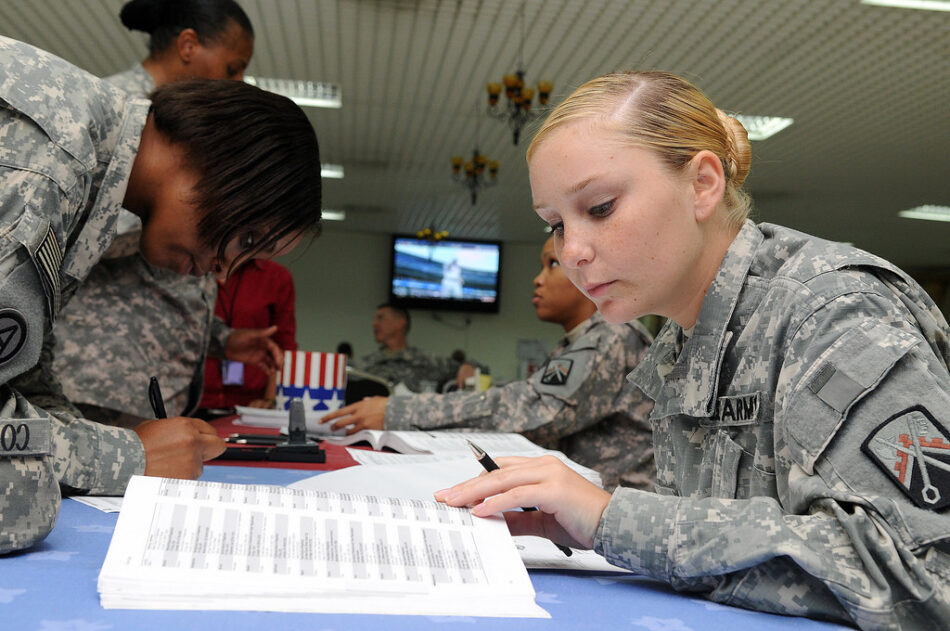What does patriotism and civic duty entail? For many, it conjures images of voting and military service, widely considered to be among the most honorable expressions of civic duty in America. Given their evident dedication to national welfare, why are active-duty military personnel not exercising their right to vote?
Data from the Federal Voting Assistance Program in 2020 reveals that merely 47 percent of military personnel exercised their voting rights, a stark contrast to the 74 percent turnout observed among civilians.
This gap in voter turnout among military members is not due to laziness or disinterest. Instead, it’s a result of the challenging circumstances they face while deployed, which make the voting process exceptionally difficult.
About three-quarters of the 1.4 million active duty military members are stationed away from their local voting areas. For them, the voting process is more complicated than for local voters.They are required to update their registration and explicitly request an absentee ballot, often needing to do so annually.
Additionally, they must adhere to state regulations on the sending and receiving of election paperwork. Oftentimes, this involves technology that is not readily available or that faces extended mailing times. Due to these challenges, most military members need to cast their votes earlier than local voters to ensure that their ballots are received before voting deadlines.
A former ROTC Cadet, who opted for anonymity due to security concerns linked to their current position, reflected on their experience in the ROTC program, underscoring that while voting was not frequently discussed, it was highly regarded as a significant civic duty.
“My latest commander for my senior year made it a point to ensure that we know we are able to have political opinions and that our votes matter,” the Cadet said.
“The thing that surprises me the most about voter turnout being low for the military is that you’re basically getting to vote on who your boss is. Imagine in a civilian job if all the employees got to cast a vote on who the CEO of their company should be.”
The former Cadet, now undergoing basic training for the Air Force, observed similar discussions in their current position. “Since being on the active-duty side, we have been notified by our voting reps about the importance of our vote and that no matter where we are in the world, we are still able to do it,” they said.
Despite the positive outlook on voting shared by military training programs, the barrier to access it is still prevalent in the armed forces.
In 2020, the FVAP found that 21 percent of military members reported encountering challenges with voting, or expressed a desire to vote but were unable to complete the process. The primary reasons cited for military members not voting included difficulties in requesting an absentee ballot, non-receipt of their absentee ballots, and challenges in the voter registration process.
Alongside the 1.4 million active-duty U.S. military personnel, the families of these armed forces members likely encounter comparable challenges when attempting to vote. Military families often experience frequent relocations, necessitating the need to register to vote in their new locations. Furthermore, for those stationed overseas, the additional step of requesting absentee ballots complicates the voting process as well.
Since 1986, active-duty military members stationed away from their voting residences have been protected by the Uniformed and Overseas Citizens Absentee Voting Act (UOCAVA). This legislation mandates that states enable these military members, their eligible family members, and overseas citizens to vote absentee in federal elections.
In 2009, amendments were made to UOCAVA to facilitate the voting process for these individuals. The amendments require states to send ballots at least 45 days before federal elections, provide at least one electronic transmission method for voting information and blank ballots, and automatically transmit ballots within the calendar year that they were requested.
Despite legislative efforts, the barriers to voting in the military persist, and active-duty military members continue to face challenges during the voting process. With the upcoming presidential election only months away, it is crucial now more than ever that the federal government works to expand easy access to voting information and registration for all active-duty military members, ensuring that their voices can be heard in the upcoming election.


